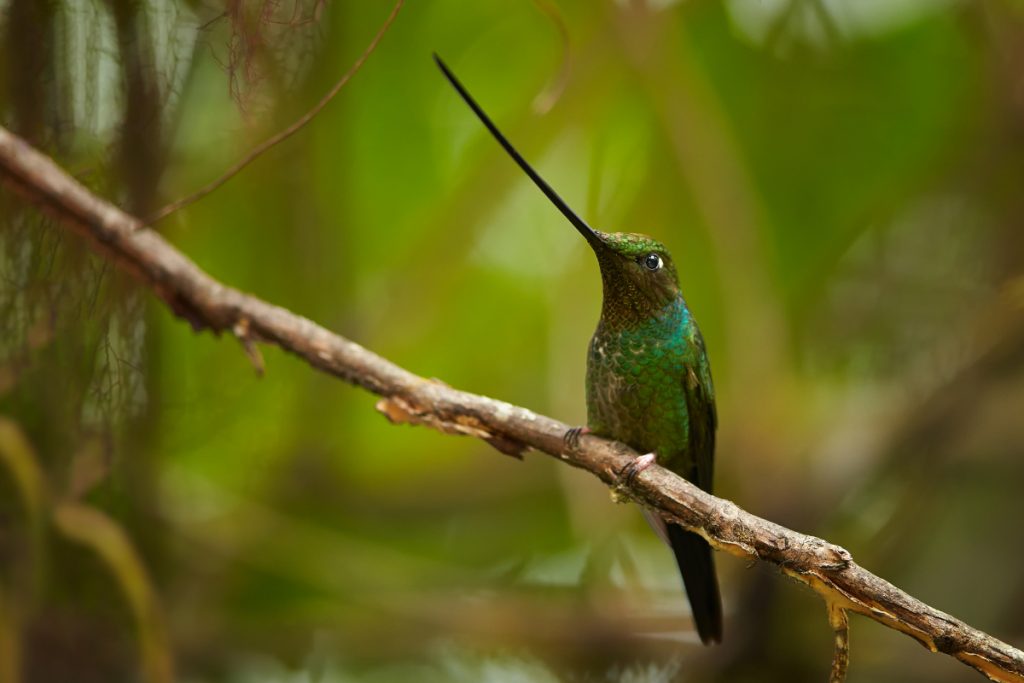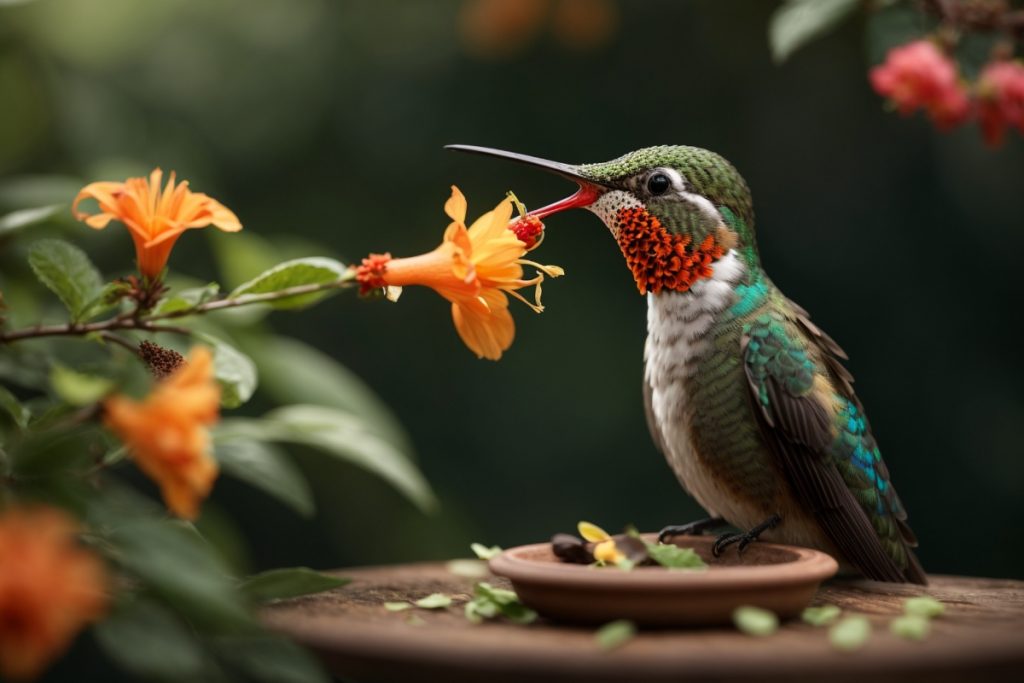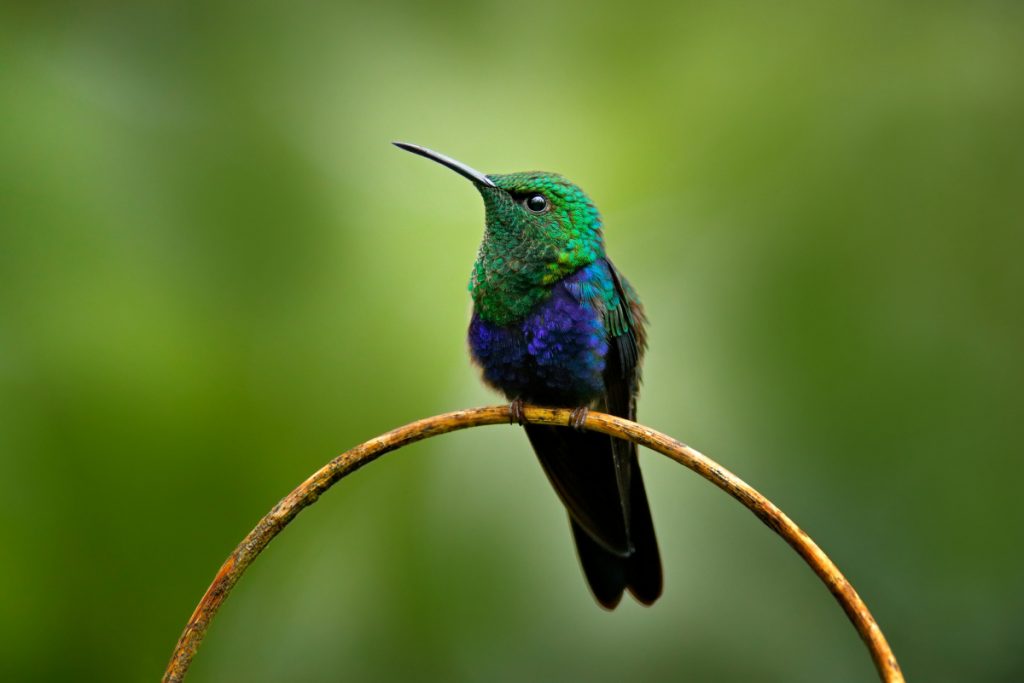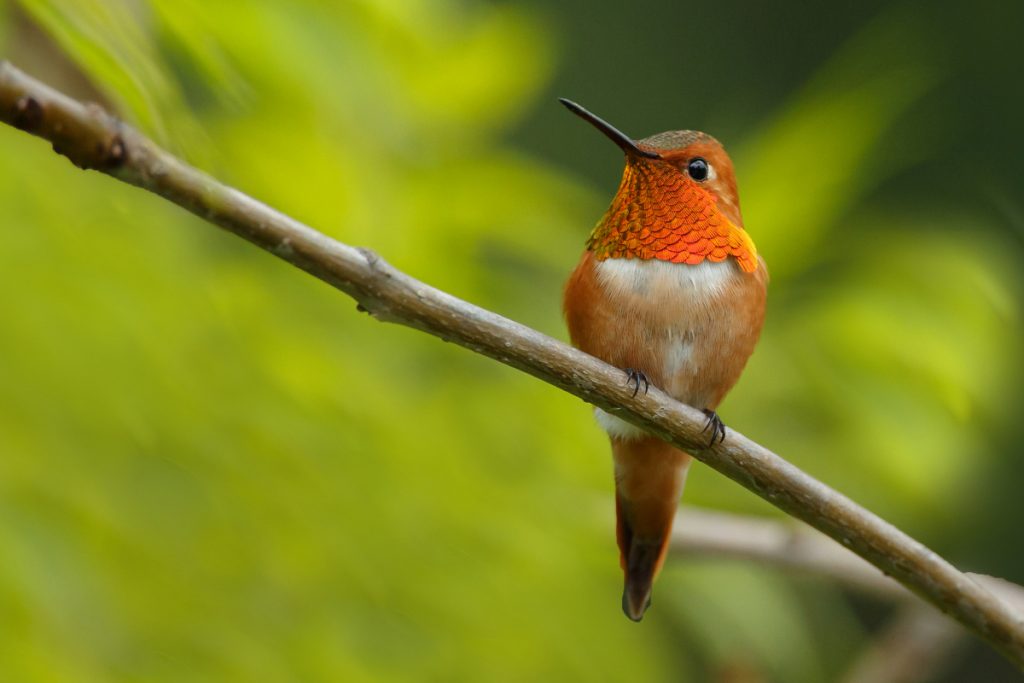Hummingbirds are known as one of the most vibrant and energetic but tiny birds. However, a significant part of their uniqueness lies in their beaks, mainly crafted to cater to their survival and comfort. One crucial question that often arises among birdwatchers is whether these birds (hummingbirds) open their beaks while feeding.
Well, you are just about to learn all you need to know about hummingbird beaks, so let’s get into it!
Do Hummingbirds Beaks Open?
Hummingbirds open their beak when feeding on foods like insects. Contrary to the common perception that their beaks are always closed due to their specialised structure for sipping nectar, hummingbirds can indeed open their beaks.
They often open their beaks when catching insects and spiders, which are essential sources of protein for them. The ability to open their beaks allows hummingbirds to have a varied diet, which is crucial for their high-energy lifestyle.

So, know that you know that hummingbirds can indeed open their beaks. Let’s explore this further, from the nitty-gritty of their beak’s structure to the foods they love and even how their beaks have changed over time.
Related post to read about Best Hummingbird Feeders
- Do Hummingbirds Beaks Open?
- Key Takeaways
- Basic Anatomy of Hummingbird's Beak
- Feeding Habits and Beak Functionality
- Adaptation and Evolution of Hummingbirds
- Hummingbird Health and Care
- A Thought to End On
- Frequently Asked Questions (FAQs)
- Q: Do hummingbirds have a beak?
- Q: What Are The Main Parts Of A Hummingbird's Beak?
- Q: How long are the beaks of common hummingbirds?
- Q: Are hummingbird beaks rigid or flexible?
- Q: Why do hummingbirds have long beaks?
- Q: How do hummingbirds use their beaks to feed on nectar?
- Q: Can hummingbirds eat solid food, and how does their beak aid in that?
- Q: How do hummingbirds catch insects with their beaks?
- Q: Are there hummingbird species with notably different beak lengths or shapes?
- Q: How do the beaks of hummingbirds compare to other bird species?
- Q: How does the entire beak of a hummingbird function in nectar extraction?
- Q: Do any hummingbirds have a hooked beak?
- Q: Can the Giant Hummingbird's beak differ from other species?
- Q: How does the upper beak of a hummingbird differ in functionality from the lower part?
- Q: What role does the slender tongue play in conjunction with the hummingbird's beak?
- Q: How do the beaks of baby hummingbirds differ from adults?
- Q: How does the hummingbird beak aid in maintaining their high-energy lifestyle?
- Q: What evolutionary theories exist around the hummingbird's beak shape and length?
- Useful Links:
Key Takeaways
- Beak Opening: Hummingbirds can open their beaks to sip nectar and catch insects.
- Beak Anatomy: Their beak has an upper (maxilla) and lower mandible, designed for reaching deep into flowers and capturing insects.
- Diet: Besides nectar, they eat insects and spiders for protein, showcasing their dietary flexibility.
- Beak Lengths: Beak lengths vary across species. On average, they measure between 15mm and 25mm. The Sword-billed hummingbird, notably, has a beak longer than its body, ranging from 80 to 120 millimetres.
Basic Anatomy of Hummingbird’s Beak
Main Parts of a Hummingbird’s Beak
Hummingbird beaks are made up of two parts:
- Upper Mandible (Maxilla): The upper part of the beak is also known as the maxilla. It is usually rigid and slightly curved, ideal for reaching into deep flowers to access nectar.
- Lower Mandible (Mandible): This is the bottom part of the beak, and it can be more flexible compared to the upper mandible. This flexibility aids in the bird’s ability to open its beak when needed.
Key Features of a Hummingbird’s Beak
- Streamlined and Elongated Shape: The beak is long and thin, enabling the bird to reach deep into flowers for nectar.
- Curved and Sharp Tip: The tip of both the upper and lower mandibles is slightly curved and sharp, aiding in the piercing and capturing of insects for protein.
Basically, understanding these different parts and features can give you a better understanding of how hummingbirds use their beaks for various important activities, like feeding on nectar and catching insects…


Hummingbird Beak lengths
Knowing the length of a hummingbird’s beak can be an excellent way to learn more about them; however, there is no one answer to the length of their beak.
Bear in mind that hummingbirds have over 350 species, and each of these species is unique in their own little way, with differences in beak length. So, their beak length will vary depending on the individual species.
Typically, the average length of a hummingbird’s beak is between 15mm and 25mm. However, the Sword-billed hummingbird has one of the longest beaks among birds, with a length ranging from 80 to 120 millimetres. Remarkably, this is the only bird species whose beak is longer than its entire body.
The difference in their beak length among different hummingbird species ensures that each type is ideally suited for accessing a range of food sources within their specific habitats.
Also, smaller beaks are better adapted for diving into flowers and extracting nectar, whereas longer beaks are more suited for plunging into tabular or trumpet-shaped flowers.
Hummingbird Beak: Rigid Or Flexible
Contrary to common belief, hummingbird beaks are not entirely rigid; they are actually quite flexible. This flexibility serves a practical purpose: it allows hummingbirds to open their beaks wide, especially when they are catching insects and spiders for food.
Basically, their beaks are not just elongated straws for sipping nectar but are also helpful tools adapted for capturing other forms of food.

Feeding Habits and Beak Functionality
Why the long beak?
Hummingbirds possess elongated beaks for a specific purpose: these long beaks enable them to reach deep into flowers to access nectar.
To extract the nectar effectively, they extend their long tongues out of the tip of their beaks.
These tongues function like tiny straws, drawing the sweet nectar up and into the hummingbirds’ mouths.
In essence, the hummingbirds’ elongated beaks and specialised tongues work together to make nectar collection an efficient and effective process.
Nectar feeding
When it comes to feeding on nectar, hummingbirds utilise their beaks very specifically. They hover gracefully in front of a flower and expertly insert their beaks into it, guiding themselves directly to the source of the sweet nectar.
Once their beaks are properly positioned, they deploy their extraordinary tongues to lap up the sugary liquid rapidly.
Basically, the beak serves as a navigational tool that directs the hummingbird precisely where it needs to go, while their specialised tongues perform the task of quick and efficient nectar consumption.
Solid food adventures
Although most birdwatchers believe that hummingbirds survive solely on nectar, they also consume solid food, mainly insects and spiders. Their beaks are not just for sipping nectar but also serve as efficient traps for capturing these tiny insects.
These tiny insects give hummingbirds the essential proteins and other nutrients their nectar-based diet lacks.
In short, their beaks are adaptable instruments that help them enjoy a well-rounded diet, balancing the sugars from nectar with the proteins from insects and spiders.
The insect catch
It may come as a surprise to you, but hummingbirds are also adept at catching insects. I mentioned this slightly in the previous paragraph; however, I’ll discuss it further here.
Their beak acts as quick and effective traps for capturing insects; this adds another layer of skill to the hummingbird’s feeding repertoire, emphasising their ability to switch between liquid and solid food sources when needed.

Adaptation and Evolution of Hummingbirds
Over time, the beaks of hummingbirds have undergone remarkable evolutionary changes to meet their specific environmental needs and survival strategies.
The dominant scientific theory suggests that longer and more flexible beaks evolved as a response to flowers with deeper structures, which usually offer more abundant nectar.
This adaptation enables more efficient nectar extraction and enhances their capability to catch and consume insects effectively.
In essence, the evolutionary design of the hummingbird’s beak is a brilliant adaptation that optimises their ability to feed and survive in diverse ecological conditions.
Diversity In Hummingbird’s Beaks
Among hummingbirds, there is an astonishing range of beak lengths and shapes, each adapted to the unique needs and environments of different species.
Take, for instance, the Sword-billed hummingbird, which has a beak so long that it exceeds its own body’s length!
On the other end of the spectrum, the Bee hummingbird, known as the smallest bird species in the world, has a proportionally petite beak.
This fascinating diversity in beaks is compelling evidence of how well these birds are adapted to their specific ecological places and feeding requirements.
Comparison With Other Birds
When compared with the beaks of other bird species, hummingbird beaks are noticeably distinct. They are extraordinarily long and slender, a design that is finely tuned for optimal feeding efficiency.
What’s more, these beaks display greater flexibility, which can be attributed to their unique feeding practices that involve both sipping nectar and capturing insects.
Basically, the design and functionality of hummingbird beaks are specialised to an extent not commonly seen in other avian species, making them highly efficient feeders.

Hummingbird Health and Care
Can a hummingbird’s beak get damaged?
Just like any other part of their body, a hummingbird’s beak can get damaged. Accidents, human-made hazards and illnesses can lead to breakages or deformities.
How can one help a hummingbird with a broken or deformed beak?
Hummingbirds with broken or deformed beaks require professional intervention. Local wildlife rehabilitation centres or avian veterinarians are equipped to help such birds.
Also, in terms of feeding, offering sugar water in feeders with large openings can also provide temporary feeding assistance.
A Thought to End On
Nature is filled with wonders, from towering mountains to the tiniest hummingbirds. And while they might be small, hummingbirds carry a world of amazement in their tiny structures.
They are basically amazing! So, the next time you see one hovering around a flower in your garden, just take a moment to appreciate nature’s gift and its true beauty. Who knows, you might just catch a glance of one opening their beak wide!
Remember, whenever you ask a question about the world around you, you simply open the door to new discoveries. So, keep asking, exploring, and admiring nature’s true beauties.
And there we have it!
If you found this post helpful, you should consider reading this other post – the mysteries of hummingbird flight.
Until next time, happy bird-watching, everyone!

Frequently Asked Questions (FAQs)
Q: Do hummingbirds have a beak?
A: Yes, hummingbirds possess a beak, which is a central feature aiding in their feeding and survival.
Q: What Are The Main Parts Of A Hummingbird’s Beak?
A: The main parts of a hummingbird’s beak are the Upper Mandible (Maxilla) and the Lower Mandible.
Q: How long are the beaks of common hummingbirds?
A: The average length of a hummingbird’s beak is between 15mm and 25mm.
Q: Are hummingbird beaks rigid or flexible?
A: Hummingbird beaks are flexible, allowing them to open their beaks wide, especially when catching insects and spiders.
Q: Why do hummingbirds have long beaks?
A: Hummingbirds have long beaks to reach deep into flowers and efficiently access nectar.
Q: How do hummingbirds use their beaks to feed on nectar?
A: Hummingbirds insert their beaks into flowers and extend their slender tongues out of their beaks’ tips to draw nectar into their mouths.
Q: Can hummingbirds eat solid food, and how does their beak aid in that?
A: Yes, hummingbirds eat solid food, primarily insects and spiders. Their beaks serve as efficient traps to capture these tiny sources of protein.
Q: How do hummingbirds catch insects with their beaks?
A: Hummingbirds use their sharp beak as a quick and effective trap for capturing insects in flight.
Q: Are there hummingbird species with notably different beak lengths or shapes?
A: Yes, hummingbirds have over 350 species, each with unique beak lengths and shapes. For instance, the Sword-billed hummingbird has a notably long beak, while the Bee hummingbird has a proportionally petite beak.
Q: How do the beaks of hummingbirds compare to other bird species?
A: Compared to other bird species, hummingbird beaks are distinctively long, slender, and flexible, specialised for optimal feeding efficiency, both in sipping nectar and capturing insects.
Q: How does the entire beak of a hummingbird function in nectar extraction?
A: The entire beak, especially its slender and elongated structure, aids in reaching deep into tubular flowers to access nectar.
Q: Do any hummingbirds have a hooked beak?
A: While most hummingbird beaks are straight or slightly curved for nectar feeding, none have a notably hooked shape, as seen in birds of prey.
Q: Can the Giant Hummingbird’s beak differ from other species?
A: Yes, the Giant Hummingbird, like other species, has a beak adapted to its specific environment and feeding requirements, which may differ in length and shape compared to other hummingbirds.
Q: How does the upper beak of a hummingbird differ in functionality from the lower part?
A: The upper beak (maxilla) is typically rigid and slightly curved, ideal for reaching into flowers, while the lower beak (mandible) can be more flexible, aiding the bird in opening its beak when needed.
Q: What role does the slender tongue play in conjunction with the hummingbird’s beak?
A: The slender tongue works with the beak, extending out to draw nectar from flowers through a capillary action process.
Q: How do the beaks of baby hummingbirds differ from adults?
A: Baby hummingbirds have shorter and softer beaks, which gradually harden and lengthen as they mature.
Q: How does the hummingbird beak aid in maintaining their high-energy lifestyle?
A: The hummingbird beak ensures they get the necessary nutrients for their high-energy needs.
Q: What evolutionary theories exist around the hummingbird’s beak shape and length?
A: The dominant scientific theory suggests that hummingbirds evolved longer and more flexible beaks in response to flowers with deeper structures, which offer more abundant nectar and better catch insects.
Useful Links:
Related Posts to Read: Hummingbirds Migrations:
- Best Hummingbird Feeders.
- When Do Hummingbirds Leave Ohio?
- When Do Hummingbirds Leave Michigan?
- When Do Hummingbirds Leave Pennsylvania?
- When Do Hummingbirds Leave Florida?
- When Do Hummingbirds Leave Oregon?
References:
- About Hummingbird (Wikipedia).
- Greenewalt, C. H. (1960). Hummingbirds. New York: Doubleday. Google Scholar.
- Carey C. The impacts of climate change on the annual cycles of birds. Philos Trans R Soc Lond B Biol Sci. 2009 Nov 27; 364(1534):3321-30. doi: 10.1098/rstb.2009.0182. PMID: 19833644; PMCID: PMC2781852.
- Rico-Guevara A, Rubega MA, Hurme KJ, Dudley R. Shifting Paradigms in the Mechanics of Nectar Extraction and Hummingbird Bill Morphology. Integr Org Biol. 2019 Jan 2;1(1):oby006. doi: 10.1093/iob/oby006. PMID: 33791513; PMCID: PMC7671138.
